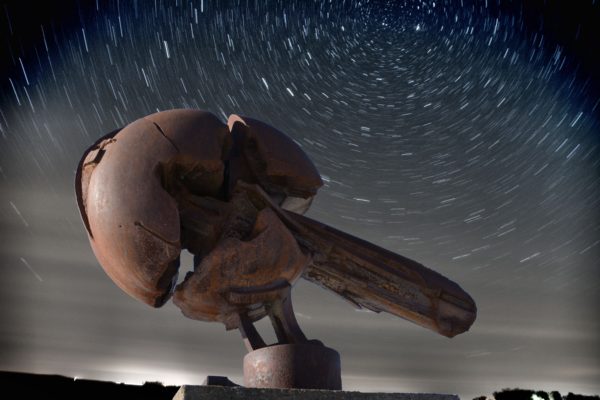
A sculpture of the meteorite that fell just north of Estherville in 1879 can be found at the Estherville Meteorite Center. Created by Tom Gibbs of Dubuque, it represents the meteor breaking into three pieces and is a popular tourist attraction. Photos courtesy of Camden Photography in Estherville
Estherville Meteorite lit up the sky before it fell to earth in 1879
By Michael Swanger
Many Iowa towns are associated with historical figures and events, but few can match the kind of meteoric legacy of Estherville where a fireball from outer space fell in the late 19th century and left a long-lasting impression on the small northern Iowa town located near the Minnesota border.
At approximately 5 p.m. on May 10, 1879, eyewitnesses from and nearby Estherville heard a loud roar from the west and observed a bright red streak in the clouds that suddenly became brilliant white in color as it burst through the clouds and exploded into three primary fragments that trailed ribbons of smoke across the Iowa sky accompanied by a shower of smaller stones. Moments later, the largest meteorite known to have fallen in North America, a.k.a. the “Estherville Meteorite,” crashed approximately two to three miles north of what would become the town of Estherville (it got its start in 1858, but wasn’t incorporated until 1881) on a farm owned by Sever Lee.
“The earth trembled, china shifted on cupboard shelves, doors and windows jarred, and window panes were broken. The explosion was followed by thunderous sounds, and the appearance of what seemed a ball of fire, traveling from southwest to the northeast. Three persons north of town, more than half a mile apart, saw dirt flying into the air. A meteor had fallen!
“Report of its light came from a wide radius. A civil engineer surveying a railroad near Jackson, Minnesota, 15 miles northwest saw the heavenly body emerge, ‘brilliantly white,’ from a storm cloud in the west. Estimating its height at 40 miles and its speed at three miles per second, he said it seemed to draw portions of the cloud after it,” claims a historical, online account of the spectacular event published by the Estherville Area Chamber of Commerce.
“Two people crossing the prairie in the open rig near Superior, Iowa, six miles west of Estherville, found themselves directly under the mass when it exploded. They reported that the three large pieces took separate direction, traveling ribbons of vapor, which formed a crow’s foot in the sky.
“A herdboy near Superior, reported that falling stones had caused his cattle to stampede, and other boys at Four Mile Lake said the placid waters had been peppered with small pebbles.”
TO READ MORE ABOUT THIS STORY AND OTHER FASCINATING STORIES ABOUT IOWA HISTORY, subscribe to Iowa History Journal. You can also purchase back issues at the store.
